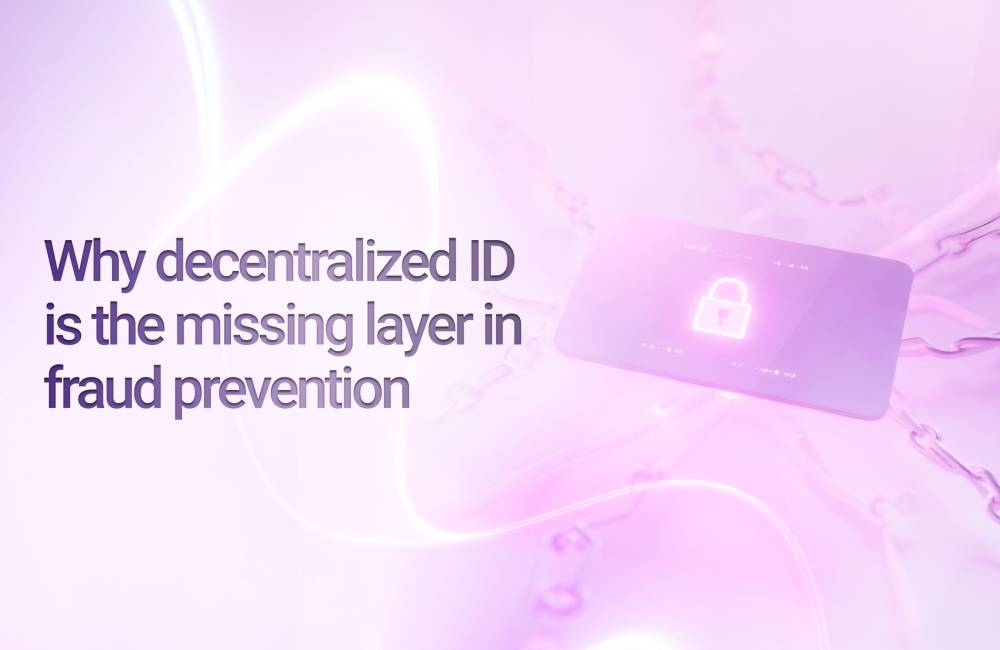Why decentralized ID is the missing layer in fraud prevention Written on

Over the past decade, biometric authentication has become synonymous with secure digital identity. Facial authentication is now standard across smartphones, banking apps, and online services. It’s no surprise: biometrics offer a fast, convenient way to prove identity, and they are far harder to steal or forget than passwords.
But convenience should not be mistaken for invulnerability.
The uncomfortable truth is this: while biometrics are a powerful tool, on their own they are not enough to prevent fraud. Especially when they are deployed in centralized systems or tied to a single device, biometrics can become just another point of failure — one that cybercriminals are increasingly learning to exploit.
That's why leading organisations across industries are turning to decentralized identity as a way to strengthen fraud prevention, protect user privacy, and future-proof their onboarding and authentication flows.

Biometrics don’t lie, but systems do
The hidden risk in traditional biometrics
It’s easy to assume that because biometrics are unique to each person, they are inherently secure. But this assumption ignores where and how biometric data is stored and used. In most cases, biometric authentication is either:
- Device-based, where biometrics are stored locally and used to unlock the device or app.
- Server-based, where biometric templates are stored in a centralized database for verification.
Both approaches come with risk. Device-based authentication (like Face ID) verifies access to the device, not the user’s identity. If someone gains control of the device they can impersonate the rightful owner with ease. Centralized biometric databases, meanwhile, create a lucrative target for attackers. Over 1 billion biometric records have been exposed through data breaches in the past decade.
Why decentralized identity changes the equation
Decentralized ID introduces a radically different model of digital identity, one that prioritises user control, privacy, and resilience. Instead of relying on a central authority to issue and store identity data, decentralized identity allows individuals to hold their own credentials securely in a digital wallet, typically verified through cryptographic proofs.
When combined with biometrics and liveness detection, decentralized ID offers a secure, scalable, and user-centric way to verify identity without creating centralised points of vulnerability.
Here’s how it works in practice:
- The user creates or receives a verified credential (e.g. proof of age, KYC verification, travel pass) which is stored locally in their digital wallet.
- When authentication is needed, the system asks the user to prove ownership of the credential (e.g. via facial biometrics + liveness check).
- The verification happens through zero-knowledge proofs or cryptographic signatures, without exposing the user’s personal data
The result? A system that is far harder to hack, spoof, or subvert, because the identity data never sits in one place, and the user remains in control.
Real-world use cases across industries
Let’s look at how this approach is already being applied in sectors where fraud prevention and trust are paramount.
1. Banking & Fintech: Protecting against identity fraud
Banks are under constant attack from fraudsters who exploit weak onboarding flows, stolen documents, and SIM swap attacks. With decentralized ID, financial institutions can verify a customer’s identity through cryptographically-secured biometric checks without relying on phone numbers, passwords, or vulnerable document uploads.
A bank can issue a verified credential after initial KYC, allowing the customer to authenticate future transactions with a biometric and liveness check from their wallet. Even if the customer’s device is lost or their number is hijacked, the identity verification remains secure, because it is bound to the person, not the device.
2. Gaming: Fighting bots and bonus abuse
Online gaming platforms face a different kind of fraud: bots, duplicate accounts, and bonus abuse. Centralised identity solutions often fail to prevent these attacks without creating friction for genuine users.
With decentralized ID, gaming companies can implement one-human-one-identity policies. A user proves their uniqueness and age through a biometric credential, without having to share personal information. This enables fair participation in tokenised ecosystems, reduces bot-driven abuse, and helps platforms stay compliant with age verification regulations.
3. Mobility & ride-sharing: Enforcing driver identity
In the mobility sector, verifying the identity of both drivers and passengers is critical for trust and safety. But relying on driver licenses and phone numbers leaves systems open to fraud, because people can share accounts, or impersonate others.
A decentralized ID system allows ride-sharing companies to issue verifiable credentials to drivers that are securely linked to their biometric identity. Any future ride requires a quick facial check with passive liveness, ensuring the person behind the wheel is the same person who was vetted. For passengers, it can also streamline check-ins and reduce friction in car-sharing or micro-mobility services.
4. Hospitality & travel: Balancing guest expectations with operational realities
Today’s travellers expect seamless, personalised, and contactless experiences. But behind the scenes, hospitality providers face mounting operational pressure: managing high guest volumes, reducing wait times, and maintaining compliance, all while safeguarding against fraud.
The traditional check-in process (with manual ID verification, physical documents, and long queles) no longer meets the expectations of digitally savvy guests. Decentralized ID offers a solution that aligns guest convenience with operational efficiency. Verified credentials and biometric authentication enable guests to check in quickly and securely, often before they even arrive, freeing up staff time and reducing human error. The result is a streamlined, secure experience that satisfies both the front desk and the guest.
Why biometrics + decentralized ID is the future
Biometrics are not going away, they are an essential part of digital identity. But to fully unlock their potential and eliminate their weaknesses, they must be paired with a decentralized identity framework.
Together, they create a verification flow that is:
- More secure, by eliminating centralized databases and hardware-based vulnerabilities.
- More private, by avoiding unnecessary data sharing.
- More user-friendly, by reducing friction without compromising security.
- More resilient, by allowing recovery and portability even if a device is lost.
Final thoughts
The future of fraud prevention lies not in doubling down on old systems, but in rethinking identity from the ground up. Decentralized ID is not just a trend, it’s a necessary evolution.
Biometrics alone can’t solve the problem. But biometrics + DID? That’s a foundation for real, lasting trust.
Want to see how it works in practice?
Download our latest eBook and explore the future of secure, user-centric identity verification.






